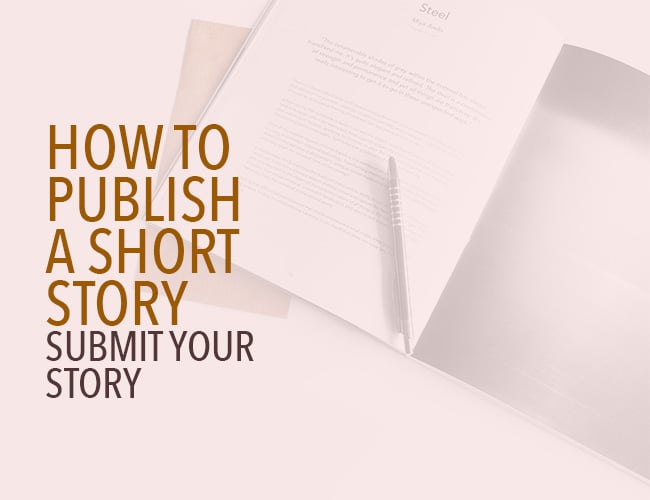Almost two months ago, we started this journey to find out how to publish a short story. We’ve drafted, we’ve gotten feedback, we’ve edited. If you’ve been following along, you should have a completed short story by now. (Mine’s ready. Is yours?)
This week, you’re sending that story out!

Just getting started on your journey toward short story publication? Look back at parts one, two, and three to find your publication and draft your story. Then, rejoin me here.
NOTE: DO NOT post your story in the comments. I’m going to ask you to submit to a publisher at the end of this post, and posting it here would be considered publishing it. Our Pro Practice Workshop Community is a great place to workshop your story before you submit it.
How to Publish a Short Story: Final Steps
Well, we’re here. You’ve planned, written, and workshopped your short story. It’s ready to go. Now it’s time to release that baby into the world!
This is the scary part. You’re looking at the guidelines for the publication you chose week one and you think your story is ready. But how exactly do you go about sending one out? What all do you need? What’s the professional etiquette?
Here are the last steps to submission:
10. Prepare Your Submission Materials
The following may seem a bit intimidating, but it’s nothing compared to writing the story. You already did the hard part.
The most important thing to remember is this: READ THE INSTRUCTIONS!
Ninety-nine percent of publications will have specific guidelines they want you to follow. You need to read them. Twice. Make sure you follow them. Some publications will reject you straight-out without reading your story if you don’t follow the instructions.
You’ve got a couple more things to think about before you can send that manuscript:
The Elevator Pitch
An elevator pitch is pretty much what it sounds like: a one to two sentence summary of your story (what you could get out in the time it takes to ride an elevator). You’ll also hear it called a premise, a summary, or a logline.
IMPORTANT: Not every publication will want this. In fact, most don’t. If they don’t specifically say they want a premise, short summary, elevator pitch, etc. in the guidelines, do not send them one.
I do recommend you prepare one at this stage, though. It’ll be easier later on when you’ve forgotten the exact point of your story and you need to have one. It’s also less stressful to have one prepared before submittal.
Formatting
Again, follow the guidelines for the publication you’re submitting to. Some publications will have their own formatting requirements, but most will use standard manuscript format (Shunn).
I recommend formatting all your stories in the Shunn format as you write them. Tweak them for any specific needs later on. It’s just easier to already have it ready to go.
The Cover Letter
Ah, the dreaded cover letter. What is it, how do you write it, and what’s the point, anyway?
Cover letters are not nearly as daunting as they seem. They’re really just a few sentences introducing yourself and your story.
You don’t need to fill a page with several paragraphs. In fact, don’t do that! Editors don’t want to spend more time reading your cover letter than they do reading your story, and they don’t need to know what made you want to write or how many pets you have.
Here’s what you need in a cover letter:
- Salutation (Dear Editor is normally fine)
- Story title and word count
- Optional: Elevator Pitch (Again, DO NOT do this unless the publication asks for it.)
- Any previous publications
- Thanks and sign
That’s it! See, not so bad.
11. Submit!
Most publications take email submissions. Some use other systems, like forms on their site, Moksha, Hey Publisher, or Submittable. You’ll find where and how to submit your story in the publication’s guidelines.
Pay special attention to the guidelines. (I know I’m starting to sound like a broken record, but I can’t stress this enough.)
Paste your cover letter in the body of your email. Most likely, unless your story is a piece of flash or you’re submitting poems, you will attach your story to the email. This is the standard way to submit, but make sure that’s how your chosen publication wants it.
Make sure you take note of what kind of file the publication wants. Some are okay with a simple DOCX format, but some want an RTF. You can change how the file is saved in the SAVE AS menu.
Make sure your story is attached before sending the email! (Seems ridiculous, but I’ve sent emails without attachments several times.)
If the publication requires a “blind read,” make sure you don’t have any identifying information on the document.
Make sure you have the correct email subject line typed. (Guidelines, again.) If you don’t, it might get lost in a spam filter. If there are no specific guidelines regarding the email subject, go with: SUBMISSION — Your Story Title — Your Last Name.
Proofread your email!
After you’ve done all that, take a deep breath. It’s time.
Hit SEND!
What to Expect After Submittal
So you’ve sent off that email or pushed the submit button in Submittable. Now your baby’s flying over the internet and landing in an editor’s slush pile. Now what?
First, make sure you record your submission somewhere. Whether it be on an online site like The Grinder, a spreadsheet, or a notebook, you need to keep track of where you send.
Now, you will wait.
And wait.
And wait.
It’s not a quick process. Most guidelines will tell you when their expected response time is, so you should have some idea of when they’ll get back to you.
But they’re often late. So be patient. Have some understanding. They’re reading hundreds of submissions and weighing them against each other. It’s not an easy job.
Do not email them over and over to ask for a status update! Be professional.
The waiting is agony, but it’s part of a writer’s job.
Submit your story to another publication if they allow simultaneous submissions. Trust me, you don’t want to wait months for a response only to be rejected and have to find another place to submit. You’ll never get published that way.
[A note on terminology: Simultaneous submissions allowed simply means they allow you to send your story to other places while they’re considering it. Multiple submissions allowed means they will take more than one story from you at once.]
The easiest way to ease the agony of waiting is to go write another story! Don’t stop with this one.
If you get rejected, don’t give up! Send it out again. Write another story and send that one out. Keep going!
Write a story, submit, and repeat: that's how to publish a short story.
Have more questions about the process? Let me know in the comments.
PRACTICE
Today, I want you to take fifteen minutes to tweak your “elevator pitch” and craft your cover letter. Then I want you to submit your story.
I know! Scary. Do it.
Then pop back over here and share your fears, excitement, or any other thoughts on the process in the comments. Don’t forget to send some encouragement to your fellow writers!
Congratulations! You’ve just submitted your short story! YOU ARE AWESOME!
Sarah Gribble is the author of dozens of short stories that explore uncomfortable situations, basic fears, and the general awe and fascination of the unknown. She just released Surviving Death, her first novel, and is currently working on her next book.
Follow her on Instagram or join her email list for free scares.




0 Comments